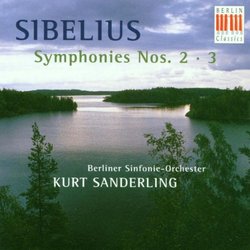| All Artists: Sibelius, Sanderling, Berlin Symphony Orchestra Title: Symphonies 2 & 3 Members Wishing: 0 Total Copies: 0 Label: Berlin Classics Release Date: 9/24/1996 Genre: Classical Style: Symphonies Number of Discs: 1 SwapaCD Credits: 1 UPC: 782124927325 |
Search - Sibelius, Sanderling, Berlin Symphony Orchestra :: Symphonies 2 & 3
CD DetailsSimilar CDs
|
CD ReviewsGood Second, excellent Third . . . 01/10/2004 (3 out of 5 stars) "Kurt Sanderling's Sibelius cycle can be very good---and occasionally exceptional---even if it remains frustratingly inconsistent. Such is the case with this cd of Symphonies 2 & 3, rather "uneven" in its current pairing. The four movements of the Second Symphony are taken at seemingly random pacing that give the music a sort of detached, if not scattered, attitude ; the sense of orchestral cohesion, so strong with Barbirolli or Beecham, is lessened. As a result, the total bundle sounds apparently variable. The first movement comes across with a torpid, inhibited, almost "disconnected" quality---in contrast to the elemental second movement (Andante, ma rubato), taken here at a somewhat hurried tempo. Undoubtedly, the performance is no lame duck and though Sanderling's sense of momentum could have been better the result is acceptable. In spite of a certain lack of vitality the music flows with temperament. As exposed here, the third movement (Vivacissimo) is very convincing, it's liveliness and forward motion being a plus. The concluding movement isn't much better than the opening one : In my opinion, it misses the key virtues of the best and most endearing accounts. Despite fine brass playing and some good points in its favor, the result has little to offer.
For comparisons, i listened to records by Colin Davis, Ashkenazy and Sakari, among others. I hold the authoritative Kajanus/LSO mono recordings from the 1930's as a steady reference. Save for the sound, the Kajanus is unquestionably a vehement demonstration of factual, rhetorical grandeur in view of the Sibelian universe ; though sometimes a bit raw, the music is imbued with nobility and with an ilk of austerity that make a vain enterprise any attempt to duplicate its strengths---perhaps a reason why Kajanus's traversals of the 2nd and 3rd symphonies are still unvanquished. Compared to Sanderling, the notorious Colin Davis (with LSO) seems to be cut from the same kind of cloth although his readings sound a notch better ; Ashkenazy (with the Philharmonia) offers clearly superior readings in finer sound. Sakari and the Iceland Symphony aren't much convincing in the 2nd but offer an excellent 3rd. Back to back, Ashkenazy's performances are to be preferred over the Sanderling set---for roughly equivalent prices. The full price Vanska and Segerstam are noticeably better, too, in their own range. The Symphony No. 3, from the same disc, is quite another story and certainly is a few notches better. It is true that you might find more exciting versions of the work---although here the gap is reduced. The dreamy, ingeniously melodic central movement is wrapped in a thoughtful, chilly atmosphere and is relatively well shaped---all in nuance and detail. The first movement is enticing as it should be. Sanderling makes the point very clear that this is no "conventional" symphony. The last movement leads to an ending of great magnitude, either esthetically or structurally. To some extent, this reading won't fail to recall a number of melodies encountered in earlier epics---such as parts of the `Four Legends'. My ratings go up for this one. To sum it up, here's an excellent Third but only a mildly good Second. In consequence, the Second Symphony, as viewed by Kurt Sanderling, isn't quite on the same exalted level as are his finest readings (above all, his sublime 1st and 6th from the same symphonic set). If you're looking for the very best Sibelius/Sanderling combination, the 1st, 3rd and 6th symphonies are recommendable highly, as does a high-profile `En Saga' from a tone-poems disc about which i sing praise (by the way, there's a powerful `Finlandia' which will not disappoint). A good example of satisfying but decidedly variable cycle. ***" |





